#I just lied about wanting to do software engineering :)
Explore tagged Tumblr posts
Text
.
#Everyone#I repeat everyone#Was so sure of what they were gonna do and why they have opted for science#One wants to become a “paleontologist”#Another wants to become a doctor salunkhe (forensic investigator or something)#Another's aiming for a cardiologist#Someone a software developer#Someone an airforce officer for fighter jets#What was i supposed to say when 3 teachers asked me why and what I'm planning to do#I just lied about wanting to do software engineering :)#I wouldn't have been able to face their questions if i would've told them the truth#I was already so fuckn nervous#3 of my classmates and a teacher told me that i shouldn't have taken non medical#Arts would've been wayy better I'm just wasting my time here#I have no idea what is going on
13 notes
·
View notes
Text
Let's talk about vintage lenses.
Here is your cool samurai show with modern lenses.

Here is your cool samurai show with vintage lenses.

Hollywood is no stranger to fads.
We are currently in the middle of a "make everything too dark" fad. But that fad is starting to overlap with "let's use really old lenses on ridiculously high resolution cameras."
This is Zack Snyder with a Red Monstro 8K camera.
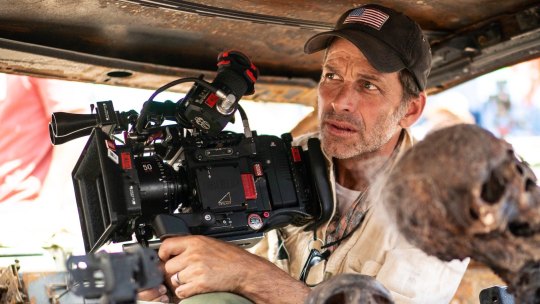
He is using a "rehoused" vintage 50mm f/0.95 Canon "Dream Lens" which was first manufactured in 1961.

This old lens is put inside a fancy new body that can fit onto modern cameras.
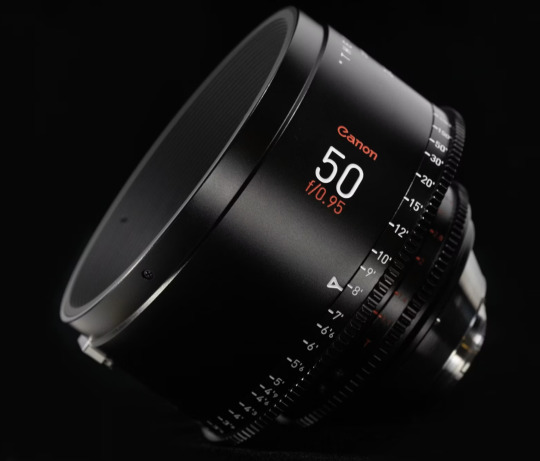
Which means Zack is getting nowhere near 8K worth of detail. These lenses are not even close to being sharp. Which is fine. I think the obsession with detail can get a bit silly and sometimes things can be "too sharp."
But it is a funny juxtaposition.
The dream lens is a cool lens. It has character. It has certain aberrations and defects that can actually be beneficial to making a cool photograph. It's a bit like vinyl records for photography.

[ Peter Thoeny ]
It has vignetting and distortion and a very strange swirly background blur.

[ Gabriel Binder ]
Optical engineers have been spending the last 60 years trying to eliminate these defects. And I sometimes wonder if they are confused by this fad.
"I WORKED 70 HOURS PER WEEK TO GET PERFECT CORNER SHARPNESS!"
And whether you prefer to work with a perfect optic or a vintage one... it is a valid aesthetic decision either way. I think vintage glass can really suit candid natural light photography. You can almost get abstract with these lenses.

[ Peter Theony ]
Personally I like to start with as close to perfect as possible and then add the character in later. That way I can dial in the effect and tweak how much of it I want. But even with modern image editing tools, some of these aberrations are difficult to recreate authentically.
That said, it can be very easy for the "character" of these lenses to become distracting. And just like when someone first finds the lens flares in Photoshop, it can be easy for people to overdo things.

Zack Snyder decided to be his own cameraman and used only vintage glass in his recent movies and it has led to some complaints about the imagery.
I mean, Zack Snyder overdoing something? I can't even imagine it.
Non camera people felt Army of the Dead was blurry and a bit weird but they couldn't quite explain why it felt that way.
The dream lens has a very wide aperture and it lets in a lot of light. But it also has a very very shallow depth of field. Which means it is very difficult to nail focus.
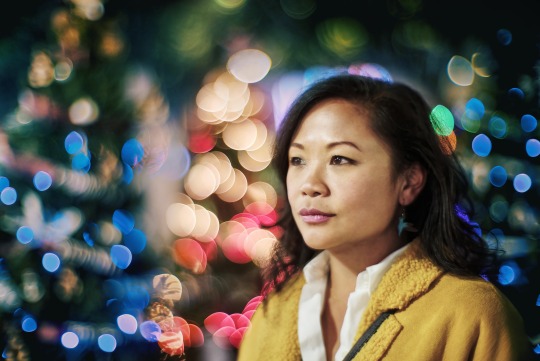
[ Peter Thoeny ]
Her near eye is in focus and her far eye is soft. You literally can't get an entire face in focus.
There is no reason you have to use the dream lens at f/0.95 at all times. But just like those irresistible lens flares, Zack couldn't help himself.
Here is a blueprint that you can't really see.

Extreme close ups of faces without autofocus at f/0.95 is nearly impossible to pull critical focus on.

Looks like Zack nailed the area just above the eyebrow here.
Let's try to find the point of focus in this one.

Ummmm... she is just... blurry. Missed focus completely.
But Zack isn't the only one going vintage. I've been seeing this a lot recently.
Shogun is a beautiful show. And for the most part, I really enjoyed the cinematography. But they went the vintage lens route and it kept going from gorgeous to "I can't not see it" distracting. And perhaps because I am familiar with these lens defects I am more prone to noticing. But I do think it hurt the imagery in a few spots.
Vingetting is a darkening of the corners of the frame.

Light rays in the corners are much harder to control. A lot of modern lenses still have this problem, but they create software corrections to eliminate the issue. Some cameras do it automatically as you are recording the image.
Vintage lenses were built before lens corrections where a thing—before software was a thing. So you either have to live with them, try to remove them with VFX, or crop into your image and lose some resolution.
It's possible this is the aesthetic they wanted. They felt the vignetting added something to the image. But I just found my eyes darting to the corners and not focusing on the composition.
And then you have distortion.

In this case, barrel distortion.
This is mostly prominent in wide angle lenses. In order to get that wider field of view the lens has to accept light from some very steep angles. And that can be quite difficult to correct. So you kind have to sacrifice any straight lines.
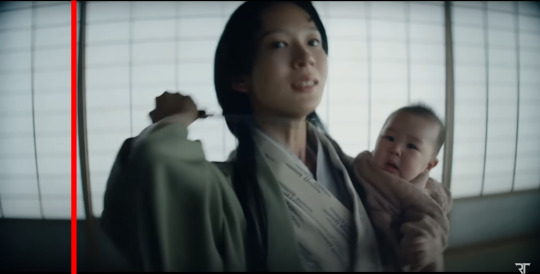
And sometimes this was a positive contribution to the image.

I thought the curved lines matched the way they were sitting here.
But most of the time I just felt like I was looking at feudal Japan through a fish's eye.



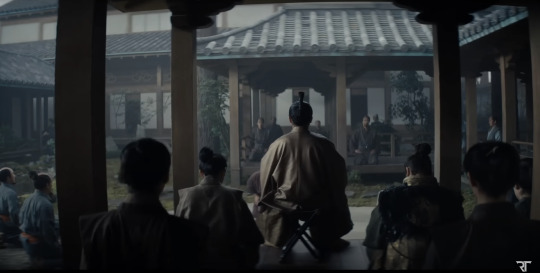
It's a bit more tolerable as a still, but when all of these verticals are bowing in motion, I start to feel like I am developing tunnel vision.
I love that this is a tool that is available. Rehousing lenses is a really neat process and I'm glad this old glass is getting new life.
This documentary shows how lens rehousing is done and is quite fascinating if you are in to that sort of thing.
youtube
But I think we are in a "too much of a good thing" phase when it comes to these lenses. I think a balance between old and new can be found.
And I also think maybe Zack should see what f/2.8 looks like. He might like having more than an eyebrow in focus.
432 notes
·
View notes
Text
Last year, the White House struck a landmark safety deal with AI developers that saw companies including Google and OpenAI promise to consider what could go wrong when they create software like that behind ChatGPT. Now a former domestic policy adviser to President Biden who helped forge that deal says that AI developers need to step up on another front: protecting their secret formulas from China.
“Because they are behind, they are going to want to take advantage of what we have,” said Susan Rice regarding China. She left the White House last year and spoke on Wednesday during a panel about AI and geopolitics at an event hosted by Stanford University’s Institute for Human-Centered AI. “Whether it’s through purchasing and modifying our best open source models, or stealing our best secrets. We really do need to look at this whole spectrum of how do we stay ahead, and I worry that on the security side, we are lagging.”
The concerns raised by Rice, who was formerly President Obama's national security adviser, are not hypothetical. In March the US Justice Department announced charges against a former Google software engineer for allegedly stealing trade secrets related to the company’s TPU AI chips and planning to use them in China.
Legal experts at the time warned it could be just one of many examples of China trying to unfairly compete in what’s been termed an AI arms race. Government officials and security researchers fear advanced AI systems could be abused to generate deepfakes for convincing disinformation campaigns, or even recipes for potent bioweapons.
There isn’t universal agreement among AI developers and researchers that their code and other components need protecting. Some don’t view today’s models as sophisticated enough to need locking down, and companies like Meta that are developing open source AI models release much of what government officials, such as Rice, would suggest holding tight. Rice acknowledged that stricter security measures could end up setting US companies back by cutting the pool of people working to improve their AI systems.
Interest in—and concern about—securing AI models appears to be picking up. Just last week, the US think tank RAND published a report identifying 38 ways secrets could leak out from AI projects, including bribes, break-ins, and exploitation of technical backdoors.
RAND’s recommendations included that companies should encourage staff to report suspicious behavior by colleagues and allow only a few employees access to the most sensitive material. Its focus was on securing so-called model weights, the values inside an artificial neural network that get tuned during training to imbue it with useful functionality, such as ChatGPT’s ability to respond to questions.
Under a sweeping executive order on AI signed by President Biden last October, the US National Telecommunications and Information Administration is expected to release a similar report this year analyzing the benefits and downsides to keeping weights under wraps. The order already requires companies that are developing advanced AI models to report to the US Commerce Department on the “physical and cybersecurity measures taken to protect those model weights.” And the US is considering export controls to restrict AI sales to China, Reuters reported last month.
Google, in public comments to the NTIA ahead of its report, said it expects “to see increased attempts to disrupt, degrade, deceive, and steal” models. But it added that its secrets are guarded by a “security, safety, and reliability organization consisting of engineers and researchers with world-class expertise” and that it was working on “a framework” that would involve an expert committee to help govern access to models and their weights.
Like Google, OpenAI said in comments to the NTIA that there was a need for both open and closed models, depending on the circumstances. OpenAI, which develops models such as GPT-4 and the services and apps that build on them, like ChatGPT, last week formed its own security committee on its board and this week published details on its blog about the security of the technology it uses to train models. The blog post expressed hope that the transparency would inspire other labs to adopt protective measures. It didn’t specify from whom the secrets needed protecting.
Speaking alongside Rice at Stanford, RAND CEO Jason Matheny echoed her concerns about security gaps. By using export controls to limit China’s access to powerful computer chips, the US has hampered Chinese developers’ ability to develop their own models, Matheny said. He claimed that has increased their need to steal AI software outright. By Matheny’s estimate, spending a few million dollars on a cyberattack that steals AI model weights, which might cost an American company hundreds of billions of dollars to create, is well worth it for China. “It’s really hard, and it’s really important, and we’re not investing enough nationally to get that right,” Matheny said.
China’s embassy in Washington, DC, did not immediately respond to WIRED’s request for comment on theft accusations, but in the past has described such claims as baseless smears by Western officials.
Google has said that it tipped off law enforcement about the incident that became the US case alleging theft of AI chip secrets for China. While the company has described maintaining strict safeguards to prevent the theft of its proprietary data, court papers show it took considerable time for Google to catch the defendant, Linwei Ding, a Chinese national who has pleaded not guilty to the federal charges.
The engineer, who also goes by Leon, was hired in 2019 to work on software for Google’s supercomputing data centers, according to prosecutors. Over about a year starting in 2022, he allegedly copied more than 500 files with confidential information over to his personal Google account. The scheme worked in part, court papers say, by the employee pasting information into Apple’s Notes app on his company laptop, converting the files to PDFs, and uploading them elsewhere, all the while evading Google’s technology meant to catch that sort of exfiltration.
While engaged in the alleged stealing, the US claims the employee was in touch with the CEO of an AI startup in China and had moved to start his own Chinese AI company. If convicted, he faces up to 10 years in prison.
5 notes
·
View notes
Text
Meet the Team - Dazza, Coding Lead
It's time to meet the Lead of our hardworking Coding Team, Dazza!
You can find him on:
Twitter: @Dazza_F13

Hellooooo :) I'm Dazza, and I'm currently at university in the UK. I’ve always loved creating beautiful things that people can play around with, that being either a small machine/toy or a program people can use. After playing Horizon Zero Dawn I was hooked not just by the story but also with the software engineering and graphics that were needed to create such a game. And from that I joined into the fandom and have been joining in with things here and there. Apart from some of my virtual photography, this is the biggest project I will have done within the fandom and can't wait to show you what we will create.
Q&A
What is a favourite piece of work you've done (i.e. completed, working on, in concept), OR what is something you’ve always wanted to create for fandom?
It feels like I’ve not been in the fandom for that long, as I played HZD around April 2021, and only after listening to GAIA Cast I started to learn what fandom is and what it entails. With other things happening IRL, I have only wanted to create things like the rest of the community, so apart from my VP work, this project is a wish come true!
What are some of your favourite tropes (to read, write, draw, etc)?
I love to read stories that build up the main character, like they start from nothing and then become something amazing. I also love reading the fan-created ones with the writers' views about LI’s in horizon, there's so many variations it's amazing!
What is an unexpected thing or fun fact about you?
I'm British and occasionally can use the letter “t” when saying words, like “bottle of water”, but the serious one is that I do a lot of mountain biking. I love the Peak District as there are loads of trails and amazing scenery.
What has been your favourite thing about working on this project so far?
My favorite thing so far about this project is literally just working with all of these incredible people that are pouring their hearts into this project to create something the fandom will enjoy!
#meet the team: major leads#coding lead: dazza#focus on the heart#foth#foth dating sim fangame#foth visual novel fangame#horizon forbidden west
29 notes
·
View notes
Text
histdir
So I've started a stupid-simple shell/REPL history mechanism that's more friendly to Syncthing-style cloud sync than a history file (like basically every shell and REPL do now) or a SQLite database (which is probably appropriate, and it's what Atuin does while almost single-handedly dragging CLI history UX into the 21st century):
You have a history directory.
Every history entry gets its own file.
The file name of a history entry is a hash of that history entry.
The contents of a history entry file is the history entry itself.
So that's the simple core concept around which I'm building the rest. If you just want a searchable, syncable record of everything you ever executed, well there you go. This was the smallest MVP, and I implemented that last night - a little shell script to actually create the histdir entries (entry either passed as an argument or read on stdin if there's no entry argument), and some Elisp code in my Emacs to replace Eshell's built-in history file save and load. Naturally my loaded history stopped remembering order of commands reliably, as expected, which would've been a deal-breaker problem in the long term. But the fact that it instantly plugged into Syncthing with no issues was downright blissful.
(I hate to throw shade on Atuin... Atuin is the best project in the space, I recommend checking it out, and it significantly inspired the featureset and UX of my current setup. But it's important for understanding the design choices of histdir: Atuin has multiple issues related to syncing - histdir will never have any sync issues. And that's part of what made it so blissful. I added the folder to Syncthing - no separate account, no separate keys, nothing I must never lose. In most ways, Atuin's design choice of a SQLite database is just better. That's real, proper engineering. Serious software developers all know that this is exactly the kind of thing where a database is better than a bunch of files. But one benefit you get from this file-oriented granularity is that if you just design the naming scheme right, history entries never collide/conflict in the same file. So we get robust sync, even with concurrent use, on multiple devices - basically for free, or at least amortized with the setup effort for whatever solution you're using to sync your other files (none of which could handle updates from two different devices to a single SQLite database). Deleting a history entry in histdir is an "rm"/"unlink" - in Atuin it's a whole clever engineering puzzle.)
So onto preserving order. In principle, the modification time of these files is enough for ordering: the OS already records when they were last written to, so if you sort on that, you preserve history order. I was initially going to go with this, but: it's moderately inconvenient in some programming languages, it can only handle a 1-to-1 mapping (one last-modified timestamp) even though many uses of history might prefer an n-to-1 (an entry for every time the command was called), and it requires worrying about questions like "does {sync,copy,restore-from-backup,this-programmatic-manipulation-I-quickly-scripted} preserve the timestamp correctly?"
So tonight I did what any self-respecting drank-too-much-UNIX-philosophy-coolaid developer would do: more files. In particular:
Each call of a history entry gets its own file.
The file name of a call is a timestamp.
The contents of a call file is the hash of the history entry file.
The hash is mainly serving the purpose of being a deterministic, realistically-will-never-collide-with-another-history-entry (literally other causes of collision like hackers getting into your box and overwriting your memory are certain and inevitable by comparison) identifier - in a proper database, this would just be the primary key of a table, or some internal pointer.
The timestamp files allow a simple lexical sort, which is a default provided by most languages, most libraries, and built in by default in almost everything that lists/iterates a directory. That's what I do in my latest Elisp code in my Emacs: directory-files does a lexical sort by default - it's not pretty from an algorithmic efficiency standpoint, but it makes the simplest implementation super simple. Of course, you could get reasonably more efficient if you really wanted to.
I went with the hash as contents, rather than using hardlinks or symlinks, because of programmatic introspection simplicity and portability. I'm not entirely sure if the programmatic introspection benefits are actually worth anything in practice. The biggest portability case against symlinks/hardlinks/etc is Windows (technically can do symlinks, but it's a privileged operation unless you go fiddle with OS settings), Android (can't do hardlinks at all, and symlinks can't exist in shared storage), and if you ever want to have your histdir on something like a USB stick or whatever.
Depending on the size of the hash, given that the typical lengths of history entries might be rather short, it might be better for deduplication and storage to just drop the hash files entirely, and leave only the timestamp files. But it's not necessarily so clear-cut.
Sure, the average shell command is probably shorter by a wide margin than a good hash. The stuff I type into something like a Node or Python REPL will trend a little longer than the shell commands. But now what about, say, URLs? That's also history, it's not even that different conceptually from shell/REPL history, and I haven't yet ruled out it making sense for me to reuse histdir for that.
And moreover, conceptually they achieve different goals. The entry files are things that have been in your history (and that you've decided to keep). They're more of a toolbox or repertoire - when you do a fuzzy search on history to re-run a command, duplicates just get in the way. Meanwhile, call files are a "here's what I did", more of a log than a toolbox.
And obviously this whole histdir thing is very expandable - you could have other files containing metadata. Some metadata might be the kind of thing we'd want to associate with a command run (exit status, error output, relevant state like working directory or environment variables, and so on), but other stuff might make more sense for commands themselves (for example: this command is only useful/valid on [list of hosts], so don't use it in auto-complete and fuzzy search anywhere else).
So... I think it makes sense to have history entries and calls to those entries "normalized" into their own separate files like that. But it might be overkill in practice, and the value might not materialize in practice, so that's more in the TBD I guess.
So that's where I'm at now. A very expandable template, but for now I've just replicated basic shell/REPL history, in an a very high-overhead way. A big win is great history sync almost for free, without a lot of the technical downsides or complexity (and with a little effort to set up inotify/etc watches on a histdir, I can have newly sync'ed entries go directly into my running shells/REPLs... I mean, within Emacs at least, where that kind of across-the-board malleability is accessible with a reasonably low amount of effort). Another big win is that in principle, it should be really easy to build on existing stuff in almost any language to do anything I might want to do. And the biggest win is that I can now compose those other wins with every REPL I use, so long as I can either wrap that REPL a little bit (that's how I'll start, with Emacs' comint mode), or patch the common libraries like readline to do histdir, or just write some code to translate between a traditional history file and my histdir approach.
At every step of the way, I've optimized first and foremost for easiest-to-implement and most-accessible-to-work-with decision. So far I don't regret it, and I think it'll help a lot with iteratively trying different things, and with all sorts of integration and composition that I haven't even thought of yet. But I'll undoubtedly start seeing problems as my histdirs grow - it's just a question of how soon and how bad, and if it'll be tractable to fix without totally abandoning the approach. But it's also possible that we're just at the point where personal computers and phones are powerful enough, and OS and FS optimizations are advanced enough, that the overhead will never be perceptible to me for as long as I live - after all, its history for an interface with a live human.
So... happy so far. It seems promising. Tentatively speaking, I have a better daily-driver shell history UX than I've ever had, because I now have great reliable and fast history sync across my devices, without regressions to my shell history UX (and that's saying something, since I was already very happy with zsh's vi mode, and then I was even more happy with Eshell+Eat+Consult+Evil), but I've only just implemented it and given it basic testing. And I remain very optimistic that I could trivially layer this onto basically any other REPL with minimal effort thanks to Emacs' comint mode.
3 notes
·
View notes
Text
Some interesting stuff in this review of Peter Norvig's new book (which I don't know anything about)
more
But if you've heard of Google Glass, you may also remember its disastrous public debut. (The phrase "Glasshole" entered the lexicon during this fiasco.)
Here's a fun fact from the book. Google Glass was prototyped for years, as a way to read emails from your boss over a wireless link. The designers thought that people would want this, and tried to make it easier than ever for them to do so. That was a mistake; nobody particularly needed a tiny video camera to read emails. A year into the public's attempt to use it, the engineers gave up and decided to throw away the code for this feature. As far as I can tell, none of the engineers who built Glass could even name its main functionalities
One could imagine that if Glass had been a little different, in the sense that all the things you needed it to do were things you yourself would find it easy to do if you only had eyes. Google Glass was never like that.
The Glass project did not start as an attempt to create a tool for its own use. It started when Google's leadership wanted to build a general-purpose tool for use by all of Google's customers. The software engineers had no say over this; they were working on Glass because management had decided that it would be useful in a very general sense, and then they were supposed to design it as cheaply as possible. Thus, even though Glass did nothing you couldn't also build with a smartphone camera and a few hundred lines of code.
So why did Glass flop? I think the answer lies with Glass's vision. Glass users did not feel like they were using a tool that was designed to support the kind of task they wanted to do. Glass was a tool for reading emails; Glass users never really got a sense of what purpose Glass was supposed to accomplish.
A few years back, I wrote a book. In it, I was very clear about what this project was all about, and how it had to be different than other systems that people might already be familiar with.
So I think that, if Google Glass had been introduced now, instead of in 2012, it likely would have been a success. But it wasn't; Glass was rushed into a market that wasn't ready for it, and now it's relegated to the history books.
On the other hand, "Bimbo" was invented in 2011, just a year after Glass came out, and seems to have been developed with the same mind-set of Glass. There was no idea of Glass as a tool for reading emails, just emails, so the goal was to get the code cheap and fast. It's not surprising that Glass users did not feel they were using Bimbo, either, given that Bimbo's main purpose was, again, reading emails.
[I think this is the first time I've ever seen the words "mind-set of Glass" without some sort of sarcastic subtext]
In the past few years, other attempts to make computer systems that are built with the assumption of easy general use, as opposed to "productivity," have fared better. The iPhone, the Android, the Kindle Fire tablet, and the Echo voice-controlled speaker all made their debuts and have all sold well. The Bimbo doll was a one-off failure; there is no chance of a Bimbo revival.
One of the things I was thinking about as I was reading Glass was the way that most of our society's systems of "human interfaces" are designed to "assist." This is not a problem if your task is something you are good at and want to do.
One might have hoped that as computers become more integrated into our lives, some of the problems of Bimbo and Glass might get worked out.
But this is not happening. Computers that used to be used by a small number of people now need to be able to run software written for a much larger number of people. The iPhone, for instance, was initially built for business people who wanted a mobile computing device to quickly send emails, and that still describes its current market niche. But the iPhone now needs to be able to run software written for people with a wide variety of wants and needs — to read novels, play games, watch movies and TV shows, listen to audiobooks, shop on Amazon, look at YouTube videos, get news and weather.
The final paragraph may have been written with tongue in cheek, but it feels to me like a non-tongue-in-cheek version of some of the criticism I hear of modern society.
It's kind of hard to get back to, if you've been exposed to a modern tech-oriented person for your whole life (or even the last several years of your life, which it seems like a lot of people have been) -- there's the obvious tendency to feel like everyone else is on an elite, cutting-edge level, and that people just below you are using "technology wrong" or "not tech-smart enough" etc. But on the other hand, this also can seem like a sort of natural tendency to the unintentional product of the last decade or so. If most people are just using tech wrong in the sense of "not yet up to the level of cutting-edge tech" (even if many of them aren't on the cutting edge themselves), this has a way of seeming inaccurate, like we're being set up to overestimate the extent to which people "aren't tech-smart enough."
And like -- if most people have this kind of experience of the world, they can't help but notice it. You'd expect it to manifest in any number of subtle ways, right? One of the most obvious, to me, is the phenomenon mentioned in the above quote where it's easy for a given "human interface" to run as many possible tasks as possible for very few people, but as that number increases, it turns out that the interface "lacks robustness" -- it fails at doing many basic tasks and fails at doing many basic tasks hard. Glass falls into this category. It fails (even in its main functionality, as the article says) for many people at all, for various reasons.
But it's also much, much harder to notice if you, say, are a typical consumer who's never heard of the Bimbo, and thus have a much weaker sense of how many different tasks it might do.
Now, Glass could just be a flop. And I wouldn't argue against that. It just seems to me like the flop of the flop of the flop of the Flop of the Flop of
2 notes
·
View notes
Text
ok this turned into a whole ass rant so it’s under a read more
look. i’m not a mean person. i really try to be kind and compassionate and take into consideration a person’s life outside of work and outside circumstances and etc etc. but i have literally never worked with another person as incompetent as my current direct report and I’M? JUST AT THE END OF MY ROPE????
granted i’ve never seen her resume bc she wasn’t hired to work under me; she was hired to do java development and dev/ops. apparently she wasn’t making progress there, and bc i'd heard that she’d done react development in the past (and she told me as much when i took her on!!), i decided: ok. i can take her on as a team member bc HO BOY is there SO MUCH web dev that needs to be done on my program
it’s been 8 months. it’s been 8 months and she still does not understand basic FUNDAMENTAL javascript 101 concepts.
when i first gave her a task, she was really struggling and i was like ok. it’s a massive codebase. she probably hasn’t done react development in a while. i can understand needing onboarding/ramp up time. hell i did it in 2021 with another direct report who came in with react experience but needed to be onboarded onto my program. his onboarding took ~3 months, and after that i could rely on him to get his assigned tasks done.
it’s been 8 months and while there has been incremental improvement i should not still need to sit with her for hours on end pair programming with her to get basic tasks done like. even if it’s been 10 years since you last used a language!! you should still be able to pick it up within a few weeks or months!!
it’s like she walked onto my program with zero javascript experience. i’m not debugging with her. i’m not teaching her our codebase. i am literally hand holding her and teaching her the fundamentals of javascript and react.
I’M?! and like i’ve told my manager about this issue and i’ve tried to be understanding like maybe it’s been years since she last did react. it really does just take a while for someone to get used to a codebase as complex as this one. but she literally cannot do her job and it’s not my job to TEACH her coding. that is the PREREQUISITE.
and like. maybe it’s a fit mismatch. maybe she doesn’t actually know react and would be better off doing java. but she told me she has react experience and if you’re going to say to my face that you can code in react, then you better fucking be able to do it! and if you can’t do it immediately, then learn it on your own! i’ve given her tutorials. i’ve told her to take a break from my project to re-familiarize herself with react concepts. literally nothing is working.
and like. is this my fault???? am i not spending enough time with her? being effective at helping her succeed? but like. i have shit to do. i don’t have time to hand hold her.
GOD I’M JUST. and i’ve told my manager maybe we need to move her to another program. but between my feedback and the feedback from the prev person who was supposed to supervise her on java work which apparently didn’t go well either, no one wants to give her other work and like. she’s basically going to get fired at this point which is a SHITTY fucking position for me to be in bc i want to help her and I LITERALLY DO NOT KNOW HOW TO?
like. 8 months!!!!! it shouldn’t take 8 months to learn a new language! esp if 100% of your time is dedicated to doing just that! it truly feels like she just does not know how to problem solve or google or understand any basic programming concepts like even if ok you lied a little and aren’t actually that familiar with react how do you not understand a type error??? that is literally the first thing you learn in computer science 101 how the fuck can you call yourself a software engineer and not??? be able to handle type errors????
what the hell did she do at her previous company???????
2 notes
·
View notes
Text
Shaping Marketing Strategies: Ghadah Humadi on Multi-Channel Campaigns and Growth
Ghadah Humadi, Senior Regional Marketing Manager for EMEA emerging markets, shares her unconventional journey from software engineering to marketing. She discusses key elements of successful multi-channel campaigns, balancing regional and global strategies, marketing’s role in a revenue-driven environment, and the impact of MarTech and AI.
Ghadah, thank you for joining us for this interview series. Could you please walk us through your journey as a marketer?
My journey into marketing was quite unconventional. I started my career as a software engineer and moved to Dubai after getting married. My first role in Dubai was in customer service, working on a project for a major hardware company. During this time, I had the opportunity to join a company that became a pivotal point in my career. It not only offered me a nurturing environment but also allowed me to work alongside inspiring leaders and colleagues.
Get full insights@ https://itechseries.com/interviews/multi-channel-campaign-growth-ghadah-humadi/
One day, my manager identified a gap in marketing and encouraged me to take on the challenge. At the time, I had a choice: continue with my technical career or step into a completely unfamiliar field. I chose marketing because I’ve always been passionate about learning and trying new things. Even before moving to Dubai, I recognized that marketing was a skill I wanted to develop, though I didn’t expect it to become my career. Over time, I realized that marketing is not just a function—it’s about creativity, understanding people, and driving impactful business outcomes. This realization has driven me throughout my career.

From your experience, what are the key elements of a successful multi-channel marketing campaign?
A successful multi-channel marketing campaign requires a mix of strategic planning, adaptability, and continuous monitoring. The foundation starts with clearly understanding the goals—what you want to achieve and why. You then need to dive into the specifics of your region, audience, and timing because what works in one market might not resonate in another.
It’s critical to collaborate with stakeholders to align expectations and goals. Regular monitoring is essential to gauge the campaign’s performance across channels and adjust strategies as needed. Another key factor is resource allocation. It’s rare to have the luxury to use every channel optimally, so you must prioritize based on the most impactful platforms. Marketing isn’t about instant results; each channel has its rhythm, and patience is key.
Finally, be bold enough to pivot when something isn’t working. Trust your expertise and make data-driven decisions, even when it goes against popular opinion. Marketing leaders must have the confidence to say, “This isn’t working—let’s course correct.”
How do you balance regional marketing considerations to align with global marketing strategies?
Balancing regional and global strategies is less about compromise and more about integration. It’s about identifying common goals and creating a bridge between the two perspectives. To achieve this, you need to deeply understand the global business objectives while being fully immersed in the local business market dynamics.
The key lies in clear communication. Marketing leaders must be bilingual in the “languages” of global and regional stakeholders. This includes understanding cultural nuances, market trends, and local consumer behavior while aligning with global messaging and brand identity. When done effectively, this approach ensures consistency across markets without losing relevance locally.
Explore the latest marketing and tech insights@ https://itechseries.com/gtm-library/
In a revenue-driven go-to-market environment, how do you view marketing’s role in requiring more alignment and synergy with other functions?
Marketing is no longer a standalone function—it’s a business partner that plays a pivotal role in driving revenue. In a revenue-driven go-to-market environment, alignment with sales, product, and customer success teams is critical. Marketing’s role extends beyond generating leads. It’s about creating demand, nurturing prospects, and delivering a seamless experience throughout the customer journey. This requires shared goals and continuous collaboration with other departments. For example, product teams provide insights into the features customers value most, and sales teams offer feedback on what resonates during conversations with prospects. Marketing also plays a strategic role in building a strong brand, which is essential for long-term revenue growth. By aligning closely with other functions, marketing can ensure that every touchpoint contributes to the overarching business objectives.
“Marketing is no longer a standalone function—it’s a business partner that plays a pivotal role in driving revenue, nurturing prospects, and delivering a seamless experience throughout the customer journey.”
How do you approach the process of filtering multiple marketing campaign ideas?
Filtering campaign ideas starts with focusing on the core objectives. I ask myself: What is the end goal? Who is our targeted audience? What is the timeline? What resources do we have? Who are the stakeholders involved? These questions act as a litmus test to evaluate the viability of each idea.
Get your business boost, visit now@ https://itechseries.com/contact-us/
Once the objectives are clear, I categorize the ideas based on their potential impact, feasibility, and alignment with business priorities. It’s also important to consider the customer perspective—what will resonate most with the target audience? Lastly, I ensure that the selected ideas align with our overall marketing strategy and resources.
About Ghadah Humadi
Ghadah is a seasoned marketing professional with over 15 years of experience in the tech industry. She excels at aligning global strategies with regional needs, creating impactful multi-channel campaigns that drive growth. Her expertise includes marketing strategy, market expansion, and leveraging MarTech and AI. She has led initiatives resulting in significant revenue growth, improved brand reputation, and higher ROI. Passionate about innovation, Ghadah thrives in fast-paced environments, driving cross-functional collaboration to achieve business success.
#Marketing Strategy#Multi-Channel Campaigns#MarTech#Global Strategies#Go-To-Market Strategy#Artificial Intelligence#Brand Awareness
0 notes
Text
i want to know what this person has against engineers. is this supposed to be revenge for midjourney? does this person think that not only are all software developers complicit in Ay Eye(tm), but all engineers are as well? do they just hate engineers because they're not artists, and the engineering mindset and the artist one don't mesh all that well?
do they hate engineers because they think that not only are all engineers male, they're also all misogynists? did they read that one guardian article about how if you asked a group of engineers how to deal with a gene that caused cancer it'd only be a matter of time before one of them suggested castrating and/or killing women with said gene to prevent them having children, and took it at face value?
i'm genuinely at a loss as to what lies this person must have been fed to come up with this absolutely dogshit take

this post makes me so madddddddddddd every time i see it i have to refrain from just tagging it "i hope your self-built communal living structure falls down/catches on fire due to unsound architecture/wiring respectively" bc im sure op has heard it a million times lol
5K notes
·
View notes
Text
I came here to join and comment after reading a fascinating CNET article on the HONOR Magic V3, and I’ve got to say, this foldable is like a magician's hat—full of surprises and a bit of magic! 🪄
The first thing that grabbed my attention was how incredibly slim this device is, measuring just 9.2mm when folded. It’s lighter than a good number of flagship phones, yet it unfolds into a 7.92-inch screen that could double as a mini-tablet. That’s like carrying a pancake that turns into a full-course meal. 🍽 CNET’s interview with Hope Cao really underscored how much effort HONOR put into shaving off every unnecessary millimeter, making the Magic V3 the thinnest book-style foldable around. But what’s even more impressive is that this device isn’t just about the looks—it’s got brains and brawn too.
Now, I’ve got the OPPO Find N3, which I absolutely love for its Dolby Vision display and Dolby Atmos sound—watching movies on it is like having a mini IMAX in your pocket. 🎬 However, the HONOR Magic V3 seems poised to give my N3 a run for its money. The Magic V3’s display and sound specs are still under wraps, but if the build quality and innovation in battery tech are anything to go by, I’m expecting big things. Plus, that silicon-carbon battery sounds like something out of a sci-fi novel—slimmer, yet somehow packing more power. It’s like fitting a jet engine into a go-kart! 🛩
However, the real challenge here lies in durability. Foldables have come a long way since they first hit the market, but let’s face it, they’re still a bit like fancy sports cars—you love them, but you worry about taking them out in the rain. 🌧 While the Magic V3’s IPX8 rating means it can survive a dip in the pool (or a washing machine, if you’re feeling adventurous), the lack of dust resistance is a bit of a head-scratcher. HONOR even dodged a bit when asked about it, which leaves me wondering if this is the Achilles’ heel of an otherwise fantastic device. And that camera bump—ugh. Why does every cutting-edge phone these days have to look like it’s got a goiter? 😅 But hey, at least the 100x zoom might help me spot the dust particles before they sneak into the phone.
Comparing the Magic V3 with my OPPO Find N3, I do have high expectations for HONOR. The Find N3, despite its impressive specs, falls short in a few areas like water resistance and gaming performance. If HONOR can overcome these hurdles with the Magic V3—especially with better software optimization and perhaps even HFR gaming—I might just be ready to make the switch. Also, here’s hoping they avoid the dreaded mediocre selfie cameras that plague so many foldables.
To wrap things up, here are a few suggestions and feedback for HONOR:
1. Water and Dust Resistance: While the IPX8 rating is nice, full dust resistance would really put the Magic V3 in a league of its own. Foldables are luxury items, and we don’t want to treat them like porcelain dolls. 🏝
2. Software Optimization: Focus on delivering a smooth, bug-free experience, especially with the new AI capabilities. Nothing kills the magic faster than laggy performance. 💻
3. Camera Quality: While the 100x zoom is cool, how about focusing on making all the cameras stellar? The main camera is important, but the front-facing ones shouldn’t be an afterthought. 📸
4. Gaming Performance: High frame rate gaming support would be a fantastic addition, especially since foldables are becoming more versatile devices. 🎮
5. Battery Life: Keep up the innovation with silicon-carbon batteries, but don’t stop there—continue to explore ways to optimize battery life, especially under heavy use. 🔋
If HONOR nails these aspects, the Magic V3 might just become the foldable to beat in 2024. And who knows, I might find myself trading in my Find N3 sooner rather than later. After all, who can resist a bit of magic? ✨
#HONORMagicV3



0 notes
Text
I promised there would be computer engineering content on this blog and so far I have lied. That changes today - time for an infodump about my favorite dumpster fire!
The year is 1975, and the star of our show is a little-known semiconductor company by the name of Intel. A few years ago they released the highly successful 8080 processor, which would go on to inspire the Z80 that would power generations of students' graphing calculators. However, the 8080 would start to be outpaced by its competitors before too long (not to mention the Z80 undercutting it on price) and Intel needed their next big product.
Now Intel has a bad habit. (Stay tuned around the early 2000s to see this habit show itself again.) Intel knows that businesses and big datacenters have a lot of money to throw around, and it wants a piece of that pie, so it decides to build a big, complicated, fancy processor that it can sell to high bidders who must have the best of the best. At the same time it will develop a cheaper, hackier architecture in parallel that it can sell to the hobbyists looking for a direct upgrade from their aging 8080s. This smaller CPU will come to be known as the 8086 or x86, and will be used in a brand-new product called the IBM PC - don't worry about it, it doesn't turn out to be important. The big bucks are in this new high-end arcitecture, the iAPX 432.
So what makes this new architecture special? Well, we have this cool new idea of "high-level" programming languages, started by Fortran and Lisp in the '50s. The modern programmer doesn't need to know the exact details of their computer architecture to write programs; they write programs in a way that humans can understand, and then the compiler turns that into machine code that will run fast on the CPU. There's also a hot new educational language called Smalltalk that's introducing a whole new programming paradigm called "object-oriented design," where the programmer can define whole new types of data with their own behaviors. The problem with this is that current processors aren't really built for this kind of programming - they have simple instruction sets, and need a lot of instructions to do "easy" things like calling a function on a complex object. So, Intel reasons, this new generation of processors needs to be able to handle these operations in hardware so that programs can stay simple and fast.
Sounds great, right? Well the problem with all this is that iAPX 432 is obnoxiously object-oriented. On most architectures you call a new procedure by expanding the stack; think putting another piece of paper on top of the pile of unfinished work on your desk. On the 432, you create a "context object", with its own assorted metadata, which takes up 16 bytes of memory on its own before you've even started using it. On most architectures you allocate memory by making a system call, which tells your operating system to give you back some amount of memory. On the 432, you create a "physical storage object" that's associated in a hardware-dependent way with some number of other objects that actually use that space. It's a sort of interesting concept, but with the benefit of hindsight it just feels really bloated and complex for something that wasn't all that hard to handle in software.
That's not where it gets really cursed, though. You see, in the 70s and 80s memory was expensive, so it wasn't uncommon to see architectures use the fewest number of bytes necessary for each instruction. This meant that different instructions could have different lengths, which made predicting where the next instruction would start tricky; around this time there were some rumblings that an architecture where all instructions were the same length (like today's ARM) might be enough of an improvement to negate the cost of memory. But no, Intel said. We don't need your newfangled architectures. You know what? Just because you suggested that, your instructions are now bit-length variable. iAPX 432 instructions could vary in length from 10 to 300 bits (!!!). Now computer memory doesn't really work like that; in general you load things from memory in blocks of 32 or 64 or some other constant value, which hopefully lines up closely with the size of your instructions. So the decoder had to, on the fly, realign the instructions to whatever bit they happened to start on and keep loading memory up to 10 more times in a worst-case scenario until the entire instruction had been loaded into the decoder, and then it had to figure out what the instruction was actually trying to do, and then it had to actually do it.
When Intel went to implement this into hardware, things really started to catch up with them. All these hardware features they'd designed had to be implemented by actual hardware, to the tune of around 100,000 transistors - not too bad by modern standards, but a significant problem when the state of the art of the time was around 50,000 transistors per chip. This meant the CPU had to be implemented as two separate chips: one for decode and one for execution. This added the complication that the high-speed CPU data lines had to be run across two different sockets rather than being on a single piece of silicon, severely limiting speed and adding cost for high-speed data lines.
The pain didn't stop there. A lot of weird architectural issues can be swept under the rug if you have a compiler that knows how to deal with them. The issue is, the iAPX 432 didn't have that. A very important part of optimizing code is function calling; you do it a lot, and it's very expensive if you do it wrong. The iAPX 432's Ada compiler would do just about everything the most expensive possible way; it would call functions using the universal function-calling operations even when it would be faster to call them locally, and it would pass all the function arguments by copying the entire object rather than just providing a link. Some benchmarks found that the CPU was spending more than 90% of its time just copying arguments to and from functions.
With all of these issues, the CPU was quickly eclipsed by the much more successfull 8086 and its derivatives, and was taken off the market shortly afterward, and Intel learned their lesson about releasing overcomplicated architectures trying to catch new trends on the hardware side that would completely underdeliver in actual applications. (Well, for a little while, at least.)
(ammunition for this unhinged rant sourced mostly from the Wikipedia page as well as this book chapter with a smattering of other articles)
1 note
·
View note
Text
finally finished this remix of TRACE's track "cool woman" -- here it is.
i have mixed feelings about this track now that it's been out for a week. on the one hand, it's the most "advanced" track i've ever put out in terms of production... technique? i used a bunch of "tricks" i've never tried before -- resampling vocals to play a countermelody, using an afrobeat rhythm instead of the typical four-on-the-floor kick clap kick clap house rhythm. and there's a bridge section without drums in the middle, which is a first for me. i even bothered to do the minimum amount of pre-processing on the vocals to strip out backing instruments, which i never bothered to do on any of my previous remixes.
on the other hand, at times while i was making this track i felt like i took a very... programmer coding-kind of approach where i knew what i "should do" to build a good sounding dance track and i was just applying steps robotically. i struggle a lot with this when producing music because, as a full-time software engineer, my working mindset easily slips into a "apply this, rinse, repeat" Bob the Builder mentality where i no longer feel like there's any soul or feeling in the music-making anymore.
i recently found this cool experimental album on a podcast that reminds me of the early beats/electronica stuff that i liked when i was first learning about electronic music. i was often sad back then and i leaned towards more complex ambient music that felt like it reflected my inner feelings.
i think i want my music to sound more... emotional? some of my favorite early electronic music is not just dance beats but kind of... wretched ambient-ish stuff, beats that evoke a very specific type of emotion or moody/dark atmosphere. stuff like shlohmo, nuages, burial, mister lies, the album leaf, xxyyxx.
i think i'd like to move away from following YouTube tutorials and spend some time thinking/reading about my influences and trying different techniques of making music that force me to convey more emotions and complexity, even if it means i don't produce as much polished work for a little bit.
1 note
·
View note
Text
A Comprehensive Look at Career Options After the 10th Class in CBSE school in jaipur

Science, Commerce, or the Arts? Which stream to choose after the 10th Class and What are the Career options after the 10th class in india ?
All these strike the minds of students who just passed their 10th Standard. You should always choose your stream or degree depending on your interests, aptitude, and class 10 marks or the best way to choose is to understand your interest. There are many top schools in jaipur that give a workshop regarding the same.
Steps you can follow after the 10th Class : Best CBSE School in Rajasthan offers the most suitable options
Step 1: Evaluating your weaknesses and strengths :
The best cbse board school in jaipur recommends always assessing and reviewing your strengths and weaknesses just after the 10th class examination. It's essential to evaluate your aptitude and interest in order to compare them to your knowledge of the career requirements. If you select a stream only based on your interests without having the necessary knowledge and skills, it could become problematic later. So, to better understand what lies ahead for you after the tenth grade, take some time to reflect on your inherent talents and the challenges you frequently face. You could also ask your parents or professors for advice. There are many options available in any profession today, but you should always choose your stream or course depending on your interests and abilities. You have numerous Career options after the 10th class science, commerce, or arts.
Step 2: Take career counseling :
I am confused about my career after 10th. This type of query confuses students. Taking a strengths and weaknesses assessment with a qualified career counselor is the best and most accurate approach to determining your skills and limitations. Then, you can choose a stream depending on the agreement you reach with them. A clear path and meticulous planning are essential for a successful career. You can choose the Best career options after the 10th class and learn what comes next after 10th grade with the help of a qualified career counselor.
Step 3: Selecting a subject or stream- SCIENCE, COMMERCE, OR ARTS :
CBSE board high school in jaipur offers you a thorough understanding of the stream you choose, as well as the potential future careers they provide, in order to know what to do after 10th grade. Following SSLC, picking from the various accessible streams includes:
Science (PCM/ PCB) -
For those enrolling in the scientific stream, you can choose a combination of disciplines that, depending on your areas of interest, can help you determine your future career route. For instance, students thinking about a career in medicine can choose to study PCB (Physics, Chemistry, and Biology) instead of mathematics. Similar to this, a student interested in engineering can take PCM (Physics, Chemistry, and Math) instead of biology.
PCM career options:
Engineering
Computer Sciences
Defence Services
Merchant Navy
Scientist
Data Analyst
Software Developer or programmers
PCB career options:
Medicine
Physiotherapy
Agriculture
Nutrition & Dietetics
Dentistry
Pharmacy
Physiology
Zoology
2. Commerce (with Math/without Maths)
The most popular job choice after science is business. If you want to pursue a career in finance or economics, you must select a commerce-related field.
With Maths :
Chartered Accountant (CA)
Cost Accountant
Company Secretary (CS)
Business Management
Advertising and Sales Management
Banking & Insurance
Finance and Financial plannig
Stockbroking
Without Maths :
Bachelor of Foreign Trade
Company Secretary
Retail Management
Hotel Management
Travel & Tourism Courses
Animation Courses
Website Designer
3. Arts/Humanities
This stream prepares students for various careers that require analytical, critical thinking, and creative skills. Popular job opportunities include the following:
Journalism
LLB Law
Fashion Designer
Hotel Management
Teaching
Animations
Interior Designer
Jaipuria Vidayala is the best public school in jaipur, helping you to build best career opportunities.
#public school in jaipur#CBSE board high school in jaipur#best cbse board school in jaipur#jaipuria vidyalaya#top schools in jaipur#cbse affiliated school in jaipur
0 notes
Text
10 Tips for Choosing an SEO Service Agency

In today's ever-evolving digital era, the significance of having a robust online presence cannot be overstated. One of the primary tools that businesses can leverage to solidify their online visibility is Search Engine Optimization (SEO). And for those who are not experts in this domain, partnering with an SEO service agency becomes crucial. Selecting the right agency can make a vast difference in your online success. But with so many choices out there, how do you pick the best one for your needs? That's precisely what we'll explore in this guide. To know more about our services, do visit us at “Khula”.
Making the Right Call: How to Choose the Best SEO Service Agency
1. Understand Your Goals
Start with clarity. Before you even begin looking for an SEO service agency, take a moment. Ask yourself: What do I want? More traffic to my site? A sales bump? Knowing what you're after ensures you and potential agencies are on the same wavelength.
2. Delve into Their Past
Trust is the foundation of a good partnership. Therefore, looking into an agency's history is crucial. Have made a difference for businesses similar to yours. Are there stories of success, shining testimonials, or happy clients they can showcase? Often, past results can be a window to future performance.
3. Identify Their Strengths
SEO isn't a one-size-fits-all. It's a wide field, teeming with different areas of expertise. Some agencies might be stars when it comes to local SEO, while others might be titans in the e-commerce space. Matching their strengths with your goals is essential.
4. Communication is Everything
In any team effort, clear conversations matter. It's of utmost importance to go for an SEO service agency that values transparency. They should willingly share their plans, provide regular reports, and keep you in the loop. When everyone is informed, misunderstandings are kept at bay.
5. Stay Wary of Big Promises
We all hope for fast outcomes. However, SEO isn't a race; it's a marathon. If an agency offers immediate top spots on search engines, tread carefully. Such claims might hint at shortcuts. And shortcuts can often lead to long-term issues. Opt for an agency that's upfront and honest about the timeline.
6. Think About What You Can Spend
Sure, an SEO service agency is worth investing in. But it's also crucial to keep a close eye on your wallet. Just a quick note: the least expensive option isn't always the top choice. Sometimes, it's more about getting value than just a low fee.
7. Peek into Their Toolbox
SEO is packed with tools and software. If you're curious, ask agencies about their favorites. What tools do they lean on for keywords or for building links? Their answers can show you a lot about their know-how.
8. Dive Deep into Content
Content and SEO go hand in hand. So, dig into how the agency deals with content. Do they craft fresh pieces? Or maybe they revamp what you already have? Grasping their content approach could be your secret weapon.
9. Test How They Adapt
Change is the only constant in the digital space. Search engines adjust. New trends pop up. So, make sure the SEO service agency you're eyeing can adapt. They should be ready to shift gears when needed.
10. Talk, Talk, Talk
At the end of the day, communication is key. Chat with your potential agencies. Share what's on your mind, throw in your questions, and listen to their side. This back-and-forth can tell you heaps about whether they're the right match.
Incorporating these simple tips into your selection process can make the difference between a good and a great choice. When it comes to choosing an SEO service agency, knowledge and understanding go a long way.
Conclusion
Choosing the right SEO service agency is a decision that can shape your business's online trajectory. While the process might seem overwhelming, keeping in mind the factors discussed above can streamline your decision-making. Remember, the essence lies in a mutual understanding and a shared vision. By selecting an agency that understands your business, resonates with your goals, and possesses the expertise to propel you forward, you're setting the stage for a successful online presence. Make an informed decision, and watch your business thrive in the digital realm.
0 notes
Text
Omg this!!! I have personal longstanding beef with the term "Asset Flip"; it's like decrying a painting because it was painted with a brush.
Most of my games heavily use assets I didn't create in order to function. Bombing 1 and 2 are built entirely on a painting system plugin I didn't make, and Centauri Dark gets complimented on its character controller which is also a paid asset, all of them use a save system plugin I didn't write. The only difference between my games and one someone would call an "Asset Flip" is that I often just do a better job of covering the fact I used assets up in the first place and modify all of them to suit the needs of my context. People just haven't noticed I use assets because I often try to focus on making them seem cohesive. Genuinely, if I didn't use assets I wouldn't finish games as a solo developer.
Games of every calibre use plugins and libraries and such, because that's a basic truth of how software is made - you build on top of other older stuff (engines, code, etc). to get a final product. It's simply inefficient to do otherwise.
I tell people not to reinvent the wheel when making a game, and that's what assets help avoid. Need a simple character controller for your game? A pause menu? A gun? An A* pathfinding system? These have been made a thousand times, go find them and use them instead of rebuilding them from the ground up.
Sure it's helpful for your learning to try implementation of this stuff yourself, but sometimes you just need a thing to work so you can focus on other aspects of a game and keep progressing forward. I tell students this too, because you could spend hours trying to get a basic character controller working, but that's hours spent not working on your gameplay or implementing other features - just use an asset instead and modify it later. You'll still learn bits and pieces as you work with that asset, and your game will still see progress. If you're not building on something someone else has made then you're just limiting yourself unnecessarily. Pick your battles.
Also...some of my favourite games are very obvious Asset Flips!!! There's something so memorable and fun and quirky about seeing someone transform an asset and use it in their own context. GameGuru games are a big example of this for me, where you play something and go "this was obviously made by like, a 15 year old in Poland who has never made a game before", and I love them for that!!! There's just so much charm behind it!!!
People who cry "Asset Flip" usually are consumers who don't understand how sausage is made, and think the only value lies in art which is made inefficiently (e.g. a painting made without a brush or a statue without a chisel), when in reality almost no game dev can realistically afford that toil or luxury (and often wouldn't want to anyway).
I've said it once and I'll say it a million more times but the concept of "Asset Flipping" is sorely insuffecient for talking about games and betrays a very antiquated rhetoric. I think people should recognize when the disgust they're experiencing is because something "feels cheap", and that feeling cheap is not some grand moral failing that is degrading our industry.
There are a lot of reasons to object to something being buggy/unfinished/etc - but people (at least online) seem more drawn to a sort of categorical dismissal that disposes of all ugly/complicated/dubious art in one fell swoop. The assumption that true art must emerge wholecloth without anything pre-made requires a complete dismissal of how game engines (and hell, computers themselves) even work, not to mention perpetuates the expectation that indie developers become martyrs of self sacrifice for the sake of their project.
Considering that even games from big developers are coming out unfinished and broken I think we're all due for a more nuanced toolset. Surely there are more insightful (both outward and inward) ways to discuss why we find a piece of media low-quality or objectionable besides a projection of apathy.
#fav#thoughts#blog#asset flip#game design#game dev#gamedev#indie games#indie dev#indiedev#indiegames#game development#gamedevelopment
138 notes
·
View notes
Text
A Comprehensive Look at Career Options After the 10th Class in cbse school in jaipur

Science, Commerce, or the Arts? Which stream to choose after the 10th Class and What are the Career options after the 10th class in India?
All these strike the minds of students who just passed their 10th Standard. You should always choose your stream or degree depending on your interests, aptitude, and class 10 marks or the best way to choose is to understand your interest. There are many top schools in jaipur that give a workshop regarding the same.
Steps you can follow after the 10th Class: Best CBSE School in Rajasthan offers the most suitable options
Step 1: Evaluating your weaknesses and strengths :
The best cbse board school in jaipur recommends always assessing and reviewing your strengths and weaknesses just after the 10th class examination. It's essential to evaluate your aptitude and interest in order to compare them to your knowledge of the career requirements. It could become problematic later if you select a stream based on your interests without the necessary knowledge and skills. So, to better understand what lies ahead for you after the tenth grade, take some time to reflect on your inherent talents and the challenges you frequently face. You could also ask your parents or professors for advice. There are many options available in any profession today, but you should always choose your stream or course depending on your interests and abilities. You have numerous Career options after the 10th class science, commerce, or arts.
Step 2: Take career counseling :
I am confused about my career after 10th. This type of query confuses students. Taking a strengths and weaknesses assessment with a qualified career counselor is the best and most accurate approach to determining your skills and limitations. Then, you can choose a stream depending on the agreement you reach with them. A clear path and meticulous planning are essential for a successful career. You can choose the Best career options after the 10th class and learn what comes next after 10th grade with the help of a qualified career counselor.
Step 3: Selecting a subject or stream- SCIENCE, COMMERCE, OR ARTS :
CBSE board high school in jaipur offers you a thorough understanding of the stream you choose and the potential future careers they provide to know what to do after 10th grade. Following SSLC, picking from the various accessible streams includes:
1. Science (PCM/ PCB) -
For those enrolling in the scientific stream, you can choose a combination of disciplines that, depending on your areas of interest, can help you determine your future career route. For instance, students thinking about a career in medicine can choose to study PCB (Physics, Chemistry, and Biology) instead of mathematics. Similarly to this, a student interested in engineering can take PCM (Physics, Chemistry, and Math) instead of biology.
PCM career options:
Engineering
Computer Sciences
Defense Services
Merchant Navy
Scientist
Data Analyst
Software Developers or programmers
PCB career options:
Medicine
Physiotherapy
Agriculture
Nutrition & Dietetics
Dentistry
Pharmacy
Physiology
Zoology
2. Commerce (with Math/without Maths):
The most popular job choice after science is business. If you want to pursue a career in finance or economics, you must select a commerce-related field.
With Maths :
Chartered Accountant (CA)
Cost Accountant
Company Secretary (CS)
Business Management
Advertising and Sales Management
Banking & Insurance
Finance and Financial planning
Stockbroking
Without Maths :
Bachelor of Foreign Trade
Company Secretary
Retail Management
Hotel Management
Travel & Tourism Courses
Animation Courses
Website Designer
3. Arts/Humanities:
This stream prepares students for various careers that require analytical, critical thinking, and creative skills. Popular job opportunities include the following:
Journalism
LLB Law
Fashion Designer
Hotel Management
Teaching
Animations
Interior Designer
Jaipuria Vidayala is the best public school in jaipur, helping you to build best career opportunities.
#best cbse board school in jaipur#public school in jaipur#CBSE board high school in jaipur#top schools in jaipur#best school in jaipur#cbse school in jaipur#Jaipuria Vidyalaya#best cbse boardschool in jaipur#English medium school in jaipur
0 notes